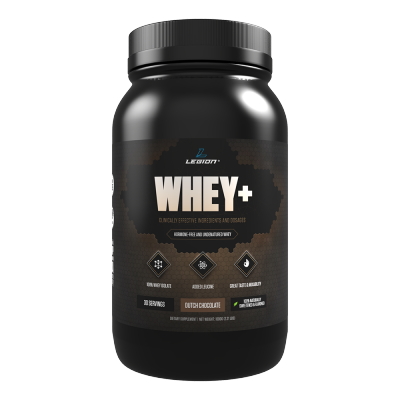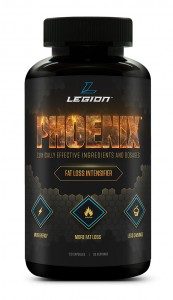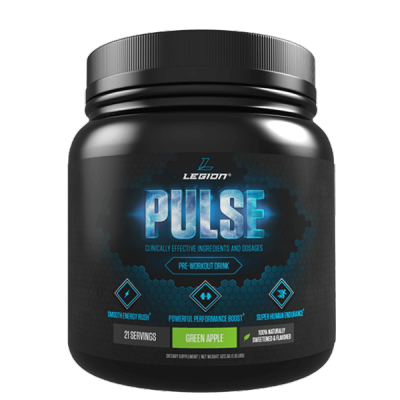Build muscle and lose fat at the same time.
It sounds so simple, right? Why shouldn’t we be able to do it?
Well, some people say it’s a fool’s errand. Others say you need to follow “special” forms of dieting and training. Others still say it takes steroids.
They’re all wrong.
Building muscle and losing fat simultaneously (or “body recomposition,” as it’s often called), isn’t beyond the power of us mere natties.
It’s doable, and it doesn’t require esoteric knowledge, fancy or newfangled methodologies, or drugs.
There’s a catch, though.
You may or may not be able to do it, depending on your body composition, training experience, and more.
So, in this article, I’m going to help you understand how body recomposition works and exactly what to do to build muscle and lose fat at the same time.
- Why Losing Fat and Gaining Muscle is Tricky
- Who Can Burn Fat and Build Muscle Effectively and Who Can't
- How to Build Muscle and Lose Fat at the Same Time
- Maintain a Moderate Calorie Deficit
- Focus on Heavy Compound Weightlifting
- Strategically Use Cardio to Burn Fat Faster
- Get Enough Sleep
- Supplement Properly
- The Bottom Line on Building Muscle and Losing Fat at the Same Time
- What do you think about building muscle and losing fat? Have anything else to share? Let me know in the comments below!
Table of Contents
Want to listen to more stuff like this? Check out my podcast!
Why Losing Fat and Gaining Muscle is Tricky
The reason why many people think building muscle and losing fat at the same time is a pipe dream has to do with something called “protein biosynthesis” or “protein synthesis.”
Every day, your cells undergo “maintenance work” whereby damaged, faulty, and degraded cells are eliminated and new cells are created to take their place.
Protein synthesis refers to the creation of new proteins inside cells and protein degradation refers to the elimination of unwanted ones.
Under normal health and dietary circumstances, muscle tissue is fairly stable and the cycle of cellular regeneration remains balanced.
That is, the average person doesn’t lose or gain muscle at an accelerated rate–his or her lean mass more or less remains level on a day-to-day basis. (If we don’t take actions to stop it, we actually slowly lose lean mass as we age, but you get the point.)
Now, when we train our muscles we damage the cells in the muscle fibers, and this signals the body to increase protein synthesis rates to repair the damage.
Our bodies are smart, too, and want to adapt to better deal with the activity that caused the muscle damage. To do this, they add cells to the muscle fibers, and this is how muscles get bigger and stronger (and why progressive overload is so important for building muscle and strength).
Thus, what we think of as just “muscle growth” is actually the result of protein synthesis rates exceeding protein breakdown rates over time.
In other words, when your body synthesizes (creates) more muscle proteins than it loses, you have gained muscle. If it creates fewer than it loses, you have lost muscle. If it creates more or less the same number as it loses, you have neither gained nor lost muscle.
This is why bodybuilders do everything they can to elevate protein synthesis rates and suppress protein degradation rates, including…
- High-protein and high-carb dieting
- Heavy compound weightlifting
- Pre-workout and post-workout nutrition
- Eating protein before bed
- Limiting cardio
- Supplementation
- (And in many cases) steroids and other drugs
In short, they are doing everything they can to bolster protein synthesis and suppress protein degradation rates with the aim of gaining as much muscle as possible.
[Read: The Best Way to Stimulate Muscle Hypertrophy (Build Muscle)]
Now that we understand the basic physiology of muscle growth, let’s look at how it’s affected by fat loss.
In order to lose fat, you need to give your body less energy (food) than it burns over time.
This is known as creating a calorie or energy deficit, and it’s the most important factor in weight loss. Regardless what you eat, if you’re eating more energy than you’re burning, you will not get leaner. Period.
While necessary for losing fat, a calorie deficit causes the body to adapt in various ways. Two adaptations are particularly relevant to the subject at hand: a reduction in both anabolic hormone levels and protein synthesis rates.
As you can imagine, these changes directly interfere with your body’s ability to create new muscle proteins.
And to make matters worse, many people trying to lose weight also make diet and training mistakes that further impair muscle building and accelerate muscle loss.
This is why it’s generally thought that you can’t build muscle while in a calorie deficit to lose fat. When in a calorie deficit, protein synthesis rates may not be able to outpace protein degradation rates and hence, no muscle growth.
Well, that’s true for some people, but not all…
Who Can Burn Fat and Build Muscle Effectively and Who Can’t

You now know what your muscles are up against when you’re in a calorie deficit and why building muscle while losing fat is an uphill–and sometimes unwinnable–battle.
The good news, however, is that if you’re anxiously reading this article, you probably can build muscle and lose fat at the same time.
I say that because you’re probably either new to weightlifting or new to proper weightlifting–weightlifting that emphasizes heavy, compound training with the primary goal of getting stronger over time (progressive overload).
And when that’s the case, I can almost guarantee that you can add muscle and lose fat at the same time.
The people who can’t, or who can only gain an amount of muscle so small that it’s negligible, are experienced weightlifters who have several years of proper training under their belts (people like me).
Unfortunately, if you’ve already achieved a large portion of your genetic potential in terms of muscle growth, you’re not going to be able to “recomp” effectively.
Instead, you’re going to want to juggle “bulking” and “cutting” periods to add muscle and fat and lose fat and not muscle, respectively.
The reason for this dramatic difference between “newbies” and veteran lifters is people new to weightlifting or proper weightlifting can benefit greatly from “newbie gains.”
The long story short is when you first start weightlifting, or first start properly overloading your muscles, your body is hyper-responsive and can gain muscle at a very fast rate.
Most guys can gain up to 25 pounds of muscle in their first year of weightlifting (and most girls can gain up to half of that). Contrast that with the reality that someone with 3+ years of proper training under their belts is limited to 3 to 5 pounds of muscle gain per year, and you see the magnitude of these effects.
The newbie “jump start” is simply large enough to overpower the muscle-related disadvantages of a calorie deficit, which still slow down muscle growth but can’t halt it altogether.
When powered by newbie gains, you won’t gain as much muscle in a calorie deficit as you would in a calorie surplus, but you can gain enough to dramatically improve your physique.
So, with that out of the way, let’s move on to how to actually build muscle and lose fat at the same time.
How to Build Muscle and Lose Fat at the Same Time
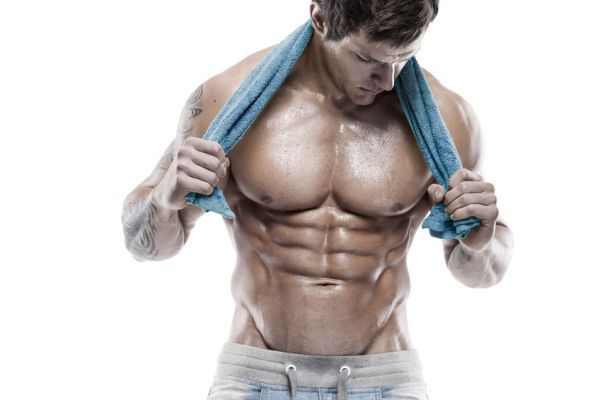
Just because your body can lose fat and build muscle simultaneously doesn’t mean it comes easily.
As I mentioned earlier, even when you do it right, muscle growth is slower while in a calorie deficit than a surplus.
It’s hard to say how much slower.
I haven’t come across any research worth citing, but I’ve worked with thousands of people and feel it’s safe to say that potential muscle gain in newbies is halved by a calorie deficit.
That is, if you could gain 10 pounds of muscle in your first 12 weeks of weightlifting if you were in a mild calorie surplus, you could expect to gain about 5 pounds if you’re in a deficit.
So be patient.
Wild claims on the Internet about losing double-digit amounts of body fat in a couple months and gaining the same in muscle are lies. What you’re usually looking at is a combination of muscle memory, drugs, and Photoshopping.
So, with that in mind, let’s take a look at how to actually go about gaining muscle and losing fat at the same time.
Maintain a Moderate Calorie Deficit
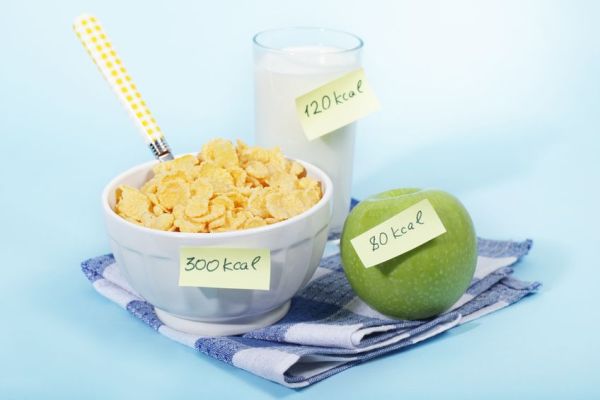
You may be able to build muscle in a calorie deficit but most definitely can’t lose fat unless you’re in a deficit, which is why a recomp requires being in a calorie deficit.
It’s important that you don’t put yourself in too large of a deficit, though, because it can lead to muscle loss, energy and mood crashes, and other problems.
How large of a deficit is too large, though? What’s optimal?
Well, we can thank researchers at the University of Jyväskylä for an answer.
They conducted a study with national- and international-level track and field jumpers and sprinters with low levels of body fat (at or under 10%), who were separated into two groups:
- A daily calorie deficit of 300 calories (about 12% below their total daily energy expenditure)
- A daily calorie deficit of 750 (about 25% less than TDEE)
Both groups ate a high-protein diet and, after 4 weeks, the athletes on a 300-calorie deficit lost very little fat and muscle while the group on a 750-calorie deficit lost, on average, about 4 pounds of fat and very little muscle.
These findings completely jive with my experience both with my body and the thousands of people I’ve worked with.
You can be aggressive (but not reckless) with your calorie restriction and dramatically increase fat loss without sacrificing muscle.
This is why I generally recommend a calorie deficit of 20 to 25% for losing fat.
(And if you’d like even more specific advice about how many calories, how much of each macronutrient, and which foods you should eat to reach your health and fitness goals, take the Legion Diet Quiz.)
[Read: How Many Calories You Should Eat (with a Calculator)]
Focus on Heavy Compound Weightlifting

The oft-repeated advice to focus on high-rep workouts to really “shred up” is idiotic.
Getting that coveted “shredded” look is only a matter of having sufficient muscle and a low body fat percentage. One style of training will not inherently make you look “more shredded” than another.
Thus, if you want to look as good as possible when you’re lean, you want to add muscle to your frame as quickly as possible.
And when that’s the goal, I can’t overstate the importance of emphasizing heavy, compound weightlifting in your workouts.
What are compound exercises?
Compound exercises involve multiple major muscle groups and require the most whole-body strength and effort.
Examples of compound exercises are the squat, deadlift, bench press, and military press.
Isolation exercises involve one muscle group and require significantly less whole-body strength and effort.
Examples of isolation exercises are the biceps curl, cable flys, and side lateral raise.
The subject of compound versus isolation exercises deserves (and will get) its own article, but here’s the long story short:
If you want to build maximum muscle and strength, you want to focus on compound exercises in your workouts.
This has been known in bodybuilding and strength training circles for decades now, and you can find scientific evidence of it as well.
There’s a good reason why the most popular weightlifting programs in the world revolve around building strength on a handful of key, compound lifts.
It works.
How heavy is “heavy”?
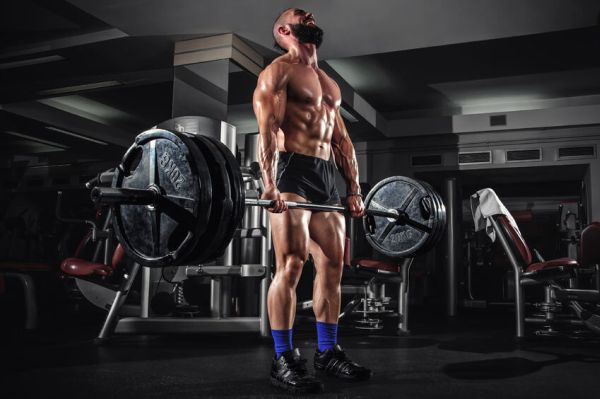
One of the first questions I had when I started lifting was how heavy I should be training.
That is, which rep range is best, and why?
Is the 10 to 12 range espoused by most fitness magazine workouts the way to go? Higher? Lower?
Well, I quickly learned that getting a simple answer to this question is far from simple. The amount of dissent among experts leaves you scratching your head, wondering whom to believe.
That was years ago, though, and I’ve done a lot of studying since and have worked with a few thousand people, and I feel I have an answer worth sharing.
And here’s what it boils down to:
If you want to maximize muscle growth, you want to train with heavy loads and a moderate volume.
That is, you want to emphasize heavy weights (80%+ of 1RM, or 4 to 6/5 to 7 rep range) and you want to do a moderate number of reps (60 to 80) per major muscle group each week.
As with the emphasis on compound movements, this is backed by decades of both anecdotal and scientific evidence.
For example, one well-designed study published earlier this year separated 33 physically active, resistance-trained men into two groups:
- A high-volume, moderate-intensity group that did 4 workouts per week consisting of 4 sets per exercise in the 10 to 12 rep range (70% of 1RM).
- A moderate-volume, high-intensity group that did 4 workouts per week consisting of 4 sets per exercise in the 3 to 5 rep range (90% of 1RM).
Both groups did the same exercises (which included the bench press, back squat, deadlift, and seated shoulder press), and both were instructed to maintain their normal eating habits (which was monitored with food diaries).
And the result?
After 8 weeks of training, scientists found that the high-intensity, moderate-volume group gained significantly more muscle and strength than the low-intensity, high-volume group.
It’s no surprise that the high-intensity group gained more strength, but many people wouldn’t have expected them to gain more muscle as well.
Researchers cite two main reasons for why the heavier training beat out the lighter:
1. Higher amounts of mechanical stress imposed on the muscles.
The high-volume training, on the other hand, caused higher amounts of metabolic stress.
2. Greater activation of muscle fibers.
And this, in turn, results in a greater adaptation across a larger percentage of the muscle tissue.
So, what can we learn from this study (and from others like it)?
1. We should focus on lifting heavy weights for fewer reps.
This is more important than maximizing cellular fatigue through high-rep sets, drop sets, giant sets, and so forth.
2. We should focus on progressive overload.
In the study outlined above, subjects increased weight on the bar after hitting their prescribed reps for two workouts.
The key here was an emphasis on overloading the muscle, not on increasing the number of reps performed.
Now, that isn’t to say that higher-rep training and isolation exercises have no place in a weightlifting program.
They just shouldn’t be the focus. You can read more about this here.
Strategically Use Cardio to Burn Fat Faster

The best way to use cardio while recomping is to do as little as needed to reach your desired rate of weight loss and stay fit, and no more.
For best results do . . .
- At least two low- to moderate-intensity cardio workouts per week of 20-to-40 minutes each.
- One HIIT workout per week if you enjoy it.
- No more than 2-to-3 hours of cardio per week.
- Cardio and weightlifting on separate days. If that isn’t possible, lift weights first and try to separate the two workouts by at least 6 hours.
Although you’ll often hear fitness gurus tout HIIT as the most effective kind of cardio for fat loss, this isn’t true. Moderate-intensity, steady-state cardio is just as good at fat-burning, easier to recover from, and doesn’t sap your motivation or energy as much as HIIT, which is why I recommend you do it for the majority of your cardio workouts.
Get Enough Sleep
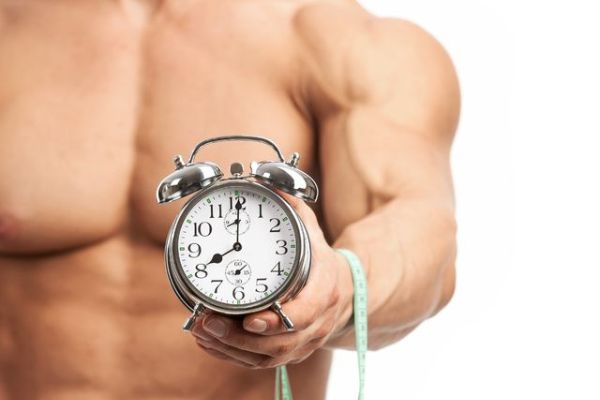
Inadequate sleep hurts both sides of your efforts to build muscle and lose fat.
Research shows that sleep deprivation causes hormonal disruptions that can cause muscle loss, which helps explain why it has been linked to muscular atrophy.
For example, one study conducted by researchers at the University of Chicago found that when 10 healthy men reduced sleep for a week from about 9 hours per night to 5, their testosterone levels dropped by up to 14%.
Insufficient sleep also decreases growth hormone and insulin-like growth factor-I (IGF-1) levels, which play important roles in maintaining and building muscle mass. Studies also show that sleep restriction raises free cortisol levels, which further impairs muscle gain.
And in terms of losing fat, sleeping too little can magnify your appetite, which makes you more likely to break your diet and overeat.
Sleep needs vary from individual to individual, but according to the National Sleep Foundation, adults need an average of 7 to 9 hours of sleep per night to be well rested.
Supplement Properly
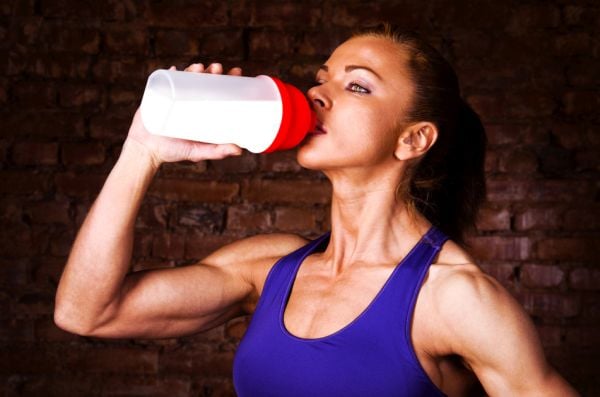
I saved this for last because, quite frankly, it’s far less important than proper diet and training.
You see, supplements don’t build great physiques–dedication to proper training and nutrition does.
Unfortunately, the workout supplement industry is plagued by pseudoscience, ridiculous hype, misleading advertising and endorsements, products full of junk ingredients, underdosing key ingredients, and many other shenanigans.
Most supplement companies produce cheap, junk products and try to dazzle you with ridiculous marketing claims, high-profile (and very expensive) endorsements, pseudo-scientific babble, fancy-sounding proprietary blends, and flashy packaging.
[Read: The Ultimate Guide to the Best (and Worst) Workout Supplements]
So, while workout supplements don’t play a vital role in building muscle and losing fat, and many are a complete waste of money…the right ones can help.
The truth of the matter is there are safe, natural substances that have been scientifically proven to deliver benefits such as increased strength, muscle endurance and growth, fat loss, and more.
As a part of my work, it’s been my job to know what these substances are, and find products with them that I can use myself and recommend to others.
Finding high-quality, effective, and fairly priced products has always been a struggle, though.
That’s why I took matters into my own hands and decided to create my own supplements. And not just another line of “me too” supplements–the exact formulations I myself have always wanted and wished others would create.
I won’t go into a whole spiel here, but if you want to learn more about my supplement line, check this out. (And if you’d like to know exactly what supplements to take to reach your fitness goals, take the Legion Supplement Finder Quiz.)
For the purpose of this article, let’s just quickly review the supplements that are going to help you get the most out of your efforts to build muscle and lose fat.
Creatine
Creatine is a substance found naturally in the body and in foods like red meat. It’s perhaps the most researched molecule in the world of sport supplements–the subject of hundreds of studies–and the consensus is very clear:
Supplementation with creatine helps…
You may have heard that creatine is bad for your kidneys, but these claims have been categorically and repeatedly disproven. In healthy subjects, creatine has been shown to have no harmful side effects, in both short- or long-term usage. People with kidney disease are not advised to supplement with creatine, however.
If you have healthy kidneys, I highly recommend that you supplement with creatine. It’s safe, cheap, and effective.
In terms of specific products, I use my own, of course, which is called RECHARGE.
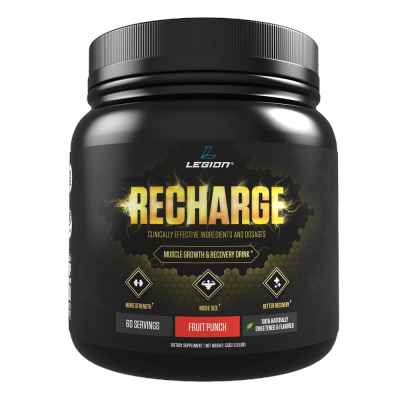 RECHARGE is 100% naturally sweetened and flavored and each serving contains:
RECHARGE is 100% naturally sweetened and flavored and each serving contains:
- 5 grams of creatine monohydrate
- 2100 milligrams of L-carnitine L-tartrate
- 10.8 milligrams of corosolic acid
This gives you the proven strength, size, and recovery benefits of creatine monohydrate plus the muscle repair and insulin sensitivity benefits of L-carnitine L-tartrate and corosolic acid.
Protein Powder
You don’t need protein supplements to gain muscle, but, considering how much protein you need to eat every day to maximize muscle growth, getting all your protein from whole food can be impractical.
That’s the main reason I created (and use) a whey protein supplement. (There’s also evidence that whey protein is particularly good for your post-workout nutrition.)
WHEY+ is 100% naturally sweetened and flavored whey isolate that is made from milk sourced from small dairy farms in Ireland, which are known for their exceptionally high-quality dairy.
I can confidently say that this is the creamiest, tastiest, healthiest all-natural whey protein powder you can find.
PHOENIX Fat Burner
With the weight loss market valued at a staggering $60.5 billion and more than one-third of U.S. adults obese, it’s no surprise that there’s a glut of “fat burners” for sale these days.
And for the same reasons it’s also no surprise that fat burners are some of the most expensive supplements on the shelves and feature some of the loudest marketing claims, often making big promises of “scientifically proven” rapid fat loss.
The reality is most “fat burners” are junk but there are a handful of natural, safe substances that have been scientifically proven to accelerate fat loss. And that’s why I created PHOENIX.
PHOENIX’s caffeine-free formulation helps you burn fat faster in three different ways:
- It dramatically increases metabolic speed.
- It amplifies the power of fat-burning chemicals produced by your body.
- It increases the feeling of fullness from food.
It accomplishes this through clinically effective dosages of several ingredients, including…
- Synephrine. This increases both basal metabolic rate and lipolysis, inhibits the activity of certain fat cell receptors that prevent fat mobilization, and increases the thermic effect of food (the “energy cost” of metabolizing food).
- Naringin. This stimulates the production of a hormone called adiponectin, which is involved in the breakdown of fat cells, and activates a type of receptor in fat cells that regulates fat mobilization (the PPARα receptor).
Through these mechanisms, naringin also works synergistically with synephrine and hesperidin to further accelerate basal metabolic rate.
- Hesperidin. Like naringin, this also stimulates the production of adiponectin and activates the PPARα receptor. It also improves blood flow and reduces the inflammation of blood vessels.
- Epigallocatechin gallate (EGCG). This inhibits the activity of a different enzyme also responsible for breaking down neurotransmitters that induce lipolysis. It has also been shown to reduce abdominal fat in particular.
- Forskolin. This increases blood plasma and intracellular levels of a molecule known as cAMP. When cAMP is high, it signifies a lack of ATP (the most basic form of cellular energy in the body) and thus initiates a process to make more ATP by burning through energy reserves (body fat).
Research has show that supplementation with forskolin accelerates fat loss and increases testosterone levels.
- And more…
The bottom line is if you want to lose fat faster without pumping yourself full of stimulants or other potentially harmful chemicals…then you want to try PHOENIX.
Pre-Workout Drink
There’s no question that a pre-workout supplement can get you fired up to get to work in the gym. There are downsides and potential risks, however.
Many pre-workout drinks are stuffed full of ineffective ingredients and/or minuscule dosages of otherwise good ingredients, making them little more than a few cheap stimulants with some “pixie dust” sprinkled in to make for a pretty label and convincing ad copy.
Many others don’t even have stimulants going for them and are just complete duds.
Others still are downright dangerous, like USPLabs’ popular pre-workout “Jack3d,”which contained a powerful (and now banned) stimulant known as DMAA.
Even worse was the popular pre-workout supplement “Craze,” which contained a chemical similar to methamphetamine.
The reality is it’s very hard to find a pre-workout supplement that’s light on stimulants but heavy on natural, safe, performance-enhancing ingredients like beta-alanine, betaine, and citrulline.
And that’s why I made my own pre-workout supplement. It’s called PULSE and it contains 6 of the most effective performance-enhancing ingredients available:
- Caffeine. Caffeine is good for more than the energy boost. It also increases muscle endurance and strength.
- Beta-Alanine. Beta-alanine is a naturally occurring amino acid that reduces exercise-induced fatigue, improves anaerobic exercise capacity, and can accelerate muscle growth.
- Citrulline Malate. Citrulline is an amino acid that improves muscle endurance, relieves muscle soreness, and improves aerobic performance.
- Betaine. Betaine is a compound found in plants like beets that improves muscle endurance, increases strength, and increases human growth hormone and insulin-like growth factor 1 production in response to acute exercise.
- Ornithine. Ornithine is an amino acid found in high amounts in dairy and meat that reduces fatigue in prolonged exercise and promotes lipid oxidation (the burning of fat for energy as opposed to carbohydrate or glycogen).
- Theanine. Theanine is an amino acid found primarily in tea that reduces the effects of mental and physical stress, increases the production of nitric oxide, which improves blood flow, and improves alertness, focus, attention, memory, mental task performance, and mood.
And what you won’t find in PULSE is equally special:
- No artificial sweeteners or flavors..
- No artificial food dyes.
- No unnecessary fillers, carbohydrate powders, or junk ingredients.
The bottom line is if you want to know what a pre-workout is supposed to feel like…if you want to experience the type of energy rush and performance boost that only clinically effective dosages of scientifically validated ingredients can deliver…then you want to try PULSE.
Again, if you feel confused about what supplements you should take to reach your goals, take the Legion Supplement Finder Quiz to learn exactly what supplements are right for you. It’s the best way to ensure you get the most out of your supplement regimen.
The Bottom Line on Building Muscle and Losing Fat at the Same Time

Building muscle and losing fat doesn’t require that you follow complex diets or training programs.
Smart, consistent application of the fundamentals of muscle growth and fat loss is all it takes.
So, to recap, here’s what it boils down to:
- Maintain a moderately aggressive calorie deficit (with proper macros)
- Emphasize heavy, compound lifting in your weightlifting workouts
- Strategically use cardio to burn fat faster
- Get plenty of sleep
- Use the right supplements to speed up the process
And your body will take care of the rest.
What do you think about building muscle and losing fat? Have anything else to share? Let me know in the comments below!
+ Scientific References
- Haskell CF, Kennedy DO, Milne AL, Wesnes KA, Scholey AB. The effects of L-theanine, caffeine and their combination on cognition and mood. Biol Psychol. 2008;77(2):113-122. doi:10.1016/j.biopsycho.2007.09.008
- Nobre AC, Rao A, Owen GN. L-theanine, a natural constituent in tea, and its effect on mental state.: Discovery Service for Endeavour College of Natural Health Library. Asia Pac J Clin Nutr. 2008;17(S1):167-168. doi:10.6133/APJCN.2008.17.S1.40
- Foxe JJ, Morie KP, Laud PJ, Rowson MJ, de Bruin EA, Kelly SP. Assessing the effects of caffeine and theanine on the maintenance of vigilance during a sustained attention task. Neuropharmacology. 2012;62(7):2320-2327. doi:10.1016/j.neuropharm.2012.01.020
- Bryan J. Psychological effects of dietary components of tea: caffeine and L-theanine. Nutr Rev. 2008;66(2):82-90. doi:10.1111/j.1753-4887.2007.00011.x
- Siamwala JH, Dias PM, Majumder S, et al. L-theanine promotes nitric oxide production in endothelial cells through eNOS phosphorylation. J Nutr Biochem. 2013;24(3):595-605. doi:10.1016/j.jnutbio.2012.02.016
- Kimura K, Ozeki M, Juneja LR, Ohira H. L-Theanine reduces psychological and physiological stress responses. Biol Psychol. 2007;74(1):39-45. doi:10.1016/j.biopsycho.2006.06.006
- Sugino T, Shirai T, Kajimoto Y, Kajimoto O. L-ornithine supplementation attenuates physical fatigue in healthy volunteers by modulating lipid and amino acid metabolism. Nutr Res. 2008;28(11):738-743. doi:10.1016/j.nutres.2008.08.008
- Apicella JM, Lee EC, Bailey BL, et al. Betaine supplementation enhances anabolic endocrine and Akt signaling in response to acute bouts of exercise. Eur J Appl Physiol. 2013;113(3):793-802. doi:10.1007/s00421-012-2492-8
- Lee EC, Maresh CM, Kraemer WJ, et al. Ergogenic effects of betaine supplementation on strength and power performance. J Int Soc Sports Nutr. 2010;7:27. doi:10.1186/1550-2783-7-27
- Trepanowski JF, Farney TM, McCarthy CG, Schilling BK, Craig SA, Bloomer RJ. The effects of chronic betaine supplementation on exercise performance, skeletal muscle oxygen saturation and associated biochemical parameters in resistance trained men. J strength Cond Res. 2011;25(12):3461-3471. doi:10.1519/JSC.0b013e318217d48d
- Bendahan D, Mattei JP, Ghattas B, Confort-Gouny S, Le Guern ME, Cozzone PJ. Citrulline/malate promotes aerobic energy production in human exercising muscle.1. Bendahan D, Mattei JP, Ghattas B, Confort-Gouny S, Le Guern ME, Cozzone PJ. Citrulline/malate promotes aerobic energy production in human exercising muscle. Br J Sports Med. Br J Sports Med. 2002;36(4):282-289. doi:10.1136/bjsm.36.4.282
- Pérez-Guisado J, Jakeman PM. Citrulline malate enhances athletic anaerobic performance and relieves muscle soreness. J strength Cond Res. 2010;24(5):1215-1222. doi:10.1519/JSC.0b013e3181cb28e0
- Kern BD, Robinson TL. Effects of β-alanine supplementation on performance and body composition in collegiate wrestlers and football players. J strength Cond Res. 2011;25(7):1804-1815. doi:10.1519/JSC.0b013e3181e741cf
- Smith AE, Walter AA, Graef JL, et al. Effects of beta-alanine supplementation and high-intensity interval training on endurance performance and body composition in men; a double-blind trial. J Int Soc Sports Nutr. 2009;6:5. doi:10.1186/1550-2783-6-5
- Derave W, Ozdemir MS, Harris RC, et al. beta-Alanine supplementation augments muscle carnosine content and attenuates fatigue during repeated isokinetic contraction bouts in trained sprinters. J Appl Physiol. 2007;103(5):1736-1743. doi:10.1152/japplphysiol.00397.2007
- Astorino TA, Rohmann RL, Firth K. Effect of caffeine ingestion on one-repetition maximum muscular strength. Eur J Appl Physiol. 2008;102(2):127-132. doi:10.1007/s00421-007-0557-x
- Beck TW, Housh TJ, Schmidt RJ, et al. The acute effects of a caffeine-containing supplement on strength, muscular endurance, and anaerobic capabilities. J strength Cond Res. 2006;20(3):506-510. doi:10.1519/18285.1
- Jagtap M, Chandola HM, Ravishankar B. Clinical efficacy of Coleus forskohlii (Willd.) Briq. (Makandi) in hypertension of geriatric population. Ayu. 2011;32(1):59-65. doi:10.4103/0974-8520.85729
- Godard MP, Johnson BA, Richmond SR. Body composition and hormonal adaptations associated with forskolin consumption in overweight and obese men. Obes Res. 2005;13(8):1335-1343. doi:10.1038/oby.2005.162
- Walsh DA, Van Patten SM. Multiple pathway signal transduction by the cAMP-dependent protein kinase. FASEB J. 1994;8(15):1227-1236. doi:10.1096/fasebj.8.15.8001734
- Maki KC, Reeves MS, Farmer M, et al. Green tea catechin consumption enhances exercise-induced abdominal fat loss in overweight and obese adults. J Nutr. 2009;139(2):264-270. doi:10.3945/jn.108.098293
- Zhu BT, Shim J-Y, Nagai M, Bai H-W. Molecular modelling study of the mechanism of high-potency inhibition of human catechol-O-methyltransferase by (-)-epigallocatechin-3-O-gallate. Xenobiotica. 2008;38(2):130-146. doi:10.1080/00498250701744641
- Rizza S, Muniyappa R, Iantorno M, et al. Citrus polyphenol hesperidin stimulates production of nitric oxide in endothelial cells while improving endothelial function and reducing inflammatory markers in patients with metabolic syndrome. J Clin Endocrinol Metab. 2011;96(5):E782-92. doi:10.1210/jc.2010-2879
- Stohs SJ, Preuss HG, Keith SC, Keith PL, Miller H, Kaats GR. Effects of p-synephrine alone and in combination with selected bioflavonoids on resting metabolism, blood pressure, heart rate and self-reported mood changes. Int J Med Sci. 2011;8(4):295-301. doi:10.7150/ijms.8.295
- Liu L, Shan S, Zhang K, Ning Z-Q, Lu X-P, Cheng Y-Y. Naringenin and hesperetin, two flavonoids derived from Citrus aurantium up-regulate transcription of adiponectin. Phytother Res. 2008;22(10):1400-1403. doi:10.1002/ptr.2504
- Gougeon R, Harrigan K, Tremblay J-F, Hedrei P, Lamarche M, Morais JA. Increase in the thermic effect of food in women by adrenergic amines extracted from citrus aurantium. Obes Res. 2005;13(7):1187-1194. doi:10.1038/oby.2005.141
- Brown CM, McGrath JC, Midgley JM, et al. Activities of octopamine and synephrine stereoisomers on alpha-adrenoceptors. Br J Pharmacol. 1988;93(2):417-429. doi:10.1111/j.1476-5381.1988.tb11449.x
- Ogden CL, Carroll MD, Kit BK, Flegal KM. Prevalence of childhood and adult obesity in the United States, 2011-2012. JAMA - J Am Med Assoc. 2014;311(8):806-814. doi:10.1001/jama.2014.732
- Food & Beverage Market Research Reports & Food & Beverage Industry Analysis | MarketResearch.com. https://www.marketresearch.com/Food-Beverage-c84/. Accessed September 16, 2019.
- More S. Global trends in milk quality: Implications for the Irish dairy industry. Ir Vet J. 2009;62(4):5-14. doi:10.1186/2046-0481-62-S4-S5
- Fukushima M, Matsuyama F, Ueda N, et al. Effect of corosolic acid on postchallenge plasma glucose levels. Diabetes Res Clin Pract. 2006;73(2):174-177. doi:10.1016/j.diabres.2006.01.010
- Ho J-Y, Kraemer WJ, Volek JS, et al. l-Carnitine l-tartrate supplementation favorably affects biochemical markers of recovery from physical exertion in middle-aged men and women. Metabolism. 2010;59(8):1190-1199. doi:10.1016/j.metabol.2009.11.012
- Francaux M, Poortmans JR. Side effects of creatine supplementation in athletes. Int J Sports Physiol Perform. 2006;1(4):311-323. http://www.ncbi.nlm.nih.gov/pubmed/19124889. Accessed September 16, 2019.
- Bizzarini E, De Angelis L. Is the use of oral creatine supplementation safe? J Sports Med Phys Fitness. 2004;44(4):411-416. http://www.ncbi.nlm.nih.gov/pubmed/15758854. Accessed September 16, 2019.
- Poortmans JR, Francaux M. Adverse effects of creatine supplementation: fact or fiction? Sports Med. 2000;30(3):155-170. doi:10.2165/00007256-200030030-00002
- Bassit RA, Pinheiro CHDJ, Vitzel KF, Sproesser AJ, Silveira LR, Curi R. Effect of short-term creatine supplementation on markers of skeletal muscle damage after strenuous contractile activity. Eur J Appl Physiol. 2010;108(5):945-955. doi:10.1007/s00421-009-1305-1
- Eckerson JM, Stout JR, Moore GA, et al. Effect of creatine phosphate supplementation on anaerobic working capacity and body weight after two and six days of loading in men and women. J Strength Cond Res. 2005;19(4):756-763. doi:10.1519/R-16924.1
- Branch, J D. Effect of creatine supplementation on body composition and performance: a meta-analysis. Int J Sport Nutr Exerc Metab. 2003;13(2):198-226. https://www.ncbi.nlm.nih.gov/pubmed/12945830. Accessed September 16, 2019.
- Nedeltcheva A V, Kilkus JM, Imperial J, Schoeller DA, Penev PD. Insufficient sleep undermines adiposity. Ann Intern Med. 2010;153(7):435-441. doi:10.1059/0003-4819-153-7-201010050-00006.Insufficient
- Buxton OM, Pavlova M, Reid EW, Wang W, Simonson DC, Adler GK. Sleep restriction for 1 week reduces insulin sensitivity in healthy men. Diabetes. 2010;59(9):2126-2133. doi:10.2337/db09-0699
- Mônico-Neto M, Antunes HKM, Dattilo M, et al. Resistance exercise: a non-pharmacological strategy to minimize or reverse sleep deprivation-induced muscle atrophy. Med Hypotheses. 2013;80(6):701-705. doi:10.1016/j.mehy.2013.02.013
- Dattilo M, Antunes HKM, Medeiros A, et al. Paradoxical sleep deprivation induces muscle atrophy. Muscle Nerve. 2012;45(3):431-433. doi:10.1002/mus.22322
- Scrimshaw NS, Habicht JP, Pellet P, Piché ML, Cholakos B. Effects of sleep deprivation and reversal of diurnal activity on protein metabolism of young men. Am J Clin Nutr. 1966;19(5):313-319. doi:10.1093/ajcn/19.5.313
- Gergley JC. Comparison of two lower-body modes of endurance training on lower-body strength development while concurrently training. J strength Cond Res. 2009;23(3):979-987. doi:10.1519/JSC.0b013e3181a0629d
- Boutcher SH. High-intensity intermittent exercise and fat loss. J Obes. 2011;2011. doi:10.1155/2011/868305
- Tremblay A, Simoneau JA, Bouchard C. Impact of exercise intensity on body fatness and skeletal muscle metabolism. Metabolism. 1994;43(7):814-818. doi:10.1016/0026-0495(94)90259-3
- Trapp EG, Chisholm DJ, Freund J, Boutcher SH. The effects of high-intensity intermittent exercise training on fat loss and fasting insulin levels of young women. Int J Obes (Lond). 2008;32(4):684-691. doi:10.1038/sj.ijo.0803781
- Treuth MS, Hunter GR, Williams M. Effects of exercise intensity on 24-h energy expenditure and substrate oxidation. Med Sci Sports Exerc. 1996;28(9):1138-1143. doi:10.1097/00005768-199609000-00009
- Brandenburg JP, Docherty D. The effects of accentuated eccentric loading on strength, muscle hypertrophy, and neural adaptations in trained individuals. J strength Cond Res. 2002;16(1):25-32. http://www.ncbi.nlm.nih.gov/pubmed/11834103. Accessed September 16, 2019.
- Clarkson PM, Nosaka K, Braun B. Muscle function after exercise-induced muscle damage and rapid adaptation. Med Sci Sports Exerc. 1992;24(5):512-520. http://www.ncbi.nlm.nih.gov/pubmed/1569847. Accessed September 16, 2019.
- Mangine GT, Hoffman JR, Gonzalez AM, et al. The effect of training volume and intensity on improvements in muscular strength and size in resistance-trained men. Physiol Rep. 2015;3(8). doi:10.14814/phy2.12472
- Huovinen HT, Hulmi JJ, Isolehto J, et al. Body composition and power performance improved after weight reduction in male athletes without hampering hormonal balance. J strength Cond Res. 2015;29(1):29-36. doi:10.1519/JSC.0000000000000619
- Wallace MB, Mills BD, Browning CL. Effects of cross-training on markers of insulin resistance/hyperinsulinemia. Med Sci Sports Exerc. 1997;29(9):1170-1175. doi:10.1097/00005768-199709000-00008
- Dolezal BA, Potteiger JA. Concurrent resistance and endurance training influence basal metabolic rate in nondieting individuals. J Appl Physiol. 1998;85(2):695-700. doi:10.1152/jappl.1998.85.2.695
- Pasiakos SM, Vislocky LM, Carbone JW, et al. Acute energy deprivation affects skeletal muscle protein synthesis and associated intracellular signaling proteins in physically active adults. J Nutr. 2010;140(4):745-751. doi:10.3945/jn.109.118372
- Cangemi R, Friedmann AJ, Holloszy JO, Fontana L. Long-term effects of calorie restriction on serum sex-hormone concentrations in men. Aging Cell. 2010;9(2):236-242. doi:10.1111/j.1474-9726.2010.00553.x
- Chargé SBP, Rudnicki M a. Cellular and molecular regu1. Chargé SBP, Rudnicki M a. Cellular and molecular regulation of muscle regeneration. Physiol. Rev. 2004;84(1):209–38. Available at: http://www.ncbi.nlm.nih.gov/pubmed/14715915.lation of muscle regeneration. Physiol Rev. 2004;84(1):209-238. doi:10.1152/physrev.00019.2003
- Rasmussen BB, Phillips SM. Contractile and nutritional regulation of human muscle growth. Exerc Sport Sci Rev. 2003;31(3):127-131. http://www.ncbi.nlm.nih.gov/pubmed/12882478. Accessed September 16, 2019.
- Bautmans I, Van Puyvelde K, Mets T. Sarcopenia and functional decline: pathophysiology, prevention and therapy. Acta Clin Belg. 64(4):303-316. doi:10.1179/acb.2009.048
- Chargé SBP, Rudnicki M a. Cellular and molecular regu1. Chargé SBP, Rudnicki M a. Cellular and molecular regulation of muscle regeneration. Physiol. Rev. 2004;84(1):209–38. Available at: http://www.ncbi.nlm.nih.gov/pubmed/14715915.lation of muscle regeneration. Physiol Rev. 2004;84(1):209-238. doi:10.1152/physrev.00019.2003


